Hippolyte, Paul, Auguste: les Flandrin, artistes et frères
Reviewed by Victor ClaassVictor Claass
Institut national d’histoire de l’art, Paris
victor.claass[at]inha.fr
Citation: Victor Claass, exhibition review of Hippolyte, Paul, Auguste: les Flandrin, artistes et frères, Nineteenth-Century Art Worldwide 20, no. 3 (Autumn 2021), https://doi.org/10.29411/ncaw.2021.20.3.23.
This work is licensed under a Creative Commons Attribution-NonCommercial 4.0 International License  unless otherwise noted.
unless otherwise noted.
Your browser will either open the file, download it to a folder, or display a dialog with options.
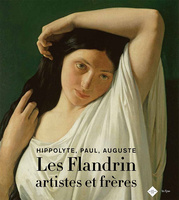
Hippolyte, Paul, Auguste: les Flandrin, artistes et frères
Lyon, Museum of Fine Arts
May 19–September 5, 2021
Catalogue:
Elena Marchetti and Stéphane Paccoud eds.,
Hippolyte, Paul, Auguste: les Flandrin, artistes et frères.
Lyon: Musée des beaux-arts/Paris, 2021.
351 pp.; 461 illus.; index; bibliography.
€39
ISBN: 978–238203–017–2
As a digital complement to the publication, the Lyon Museum of Fine Arts released catalogue entries for each exhibited work:
https://www.mba-lyon.fr/
Some thirty years after the pioneering retrospective devoted to the Flandrin “triumvirate” in 1984–85, the Lyon Museum of Fine Arts is presenting a new and ambitious exhibition of the work of these brothers and followers of Jean-Auguste-Dominique Ingres. The show is the result of the joint work of Elena Marchetti, curator at the Fondazione Musei Civici in Venice, and Stéphane Paccoud, chief curator of nineteenth-century painting and sculpture at the Lyon museum. The lavishly illustrated catalogue that accompanies the event is nearly 350 pages long, dense, and meticulously documented, and will undoubtedly stand out as an essential milestone in the research on and around the intersecting careers of Hippolyte, Paul, and Auguste Flandrin. The exhibition, which presents a considerable number of previously unseen works and documents, unfolds in a particularly well composed scenography elaborated by Flavio Bonuccelli: the layout distinguishes itself with its legibility, elegance, and the use of powerful colors, which nonetheless do not intrude on the appreciation of the works. The narrative is subdivided into nine chapters, each of which is echoed and deepened in their content within the various catalogue essays. The preferred approach is chrono-thematic and proposes parallel paths through the careers of the siblings and their artistic production.
If the exhibition demonstrates that its topic opens up new questions for future research—the curators and authors of the catalogue evoke a “work in progress” (13)—a rehabilitation process is no longer necessary. Seeing and reading about the Flandrin brothers today provides an opportunity to go back to the extensive catalogue of the 1984 retrospective and its long introduction written by Jacques Foucart. With the help of a particularly energetic style, Foucart felt the urge to defend a cause and bring the painters out of a “long and very unfair indifference.”[1] In his exclamatory and militant essay (whose relentlessly emphatic tone was already noted in its time),[2] the author expressed the wish for a more inclusive approach to nineteenth-century art, at a moment when debates raged around the soon-to-be-opened Orsay Museum and the place reserved for academic art in the canon. More than three decades later, these controversies are no longer relevant. The catalogue, edited by Paccoud and Marchetti, no longer needs to fight this battle and offers a complete update of the state of knowledge on the Flandrin brothers, while taking into account the most recent research.
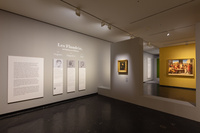
The introductory room of the exhibition allows visitors to familiarize themselves with the Lyon-born siblings, whose modest social background is emphasized, and gives an initial overview of their shared ambitions (fig. 1). Hippolyte (1809–64), whose career was punctuated by various honors and numerous prestigious commissions, was undoubtedly the most celebrated of the three. He died at the age of 55, before his master Ingres, at the height of his glory. The eldest, Auguste (1804–42), who professionally sacrificed himself for the benefit of his brothers, initiated his career as a lithographer in Lyon before resuming his training in Paris in Ingres’ studio. He stands out as the most isolated of the three, both artistically and historiographically. As for the youngest, Paul (1811–1902), more closely linked to Hippolyte’s career and activities, the exhibition highlights his talent as a landscape painter and clarifies the terms of his regular collaboration with his elder brother. A carefully chosen selection of painted or drawn portraits and self-portraits, as well as photographs, places the exhibition as a whole under the sign of a deliberately intertwined study of their trajectories. The stunning 1835 double self-portrait drawn in pencil from the Louvre Museum, in which the two brothers portray each other with affection and complicity, playfully reveals some aspects of their relationship. In the background, Paul admiringly observes Hippolyte sitting in the foreground, pensive, in a pose that is both casual and confident.
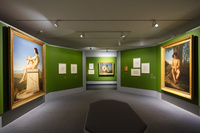
The artists’ training, initiated in Lyon among Fleury Richard’s students and completed in Paris and then in Italy, is the subject of the following section, in which drawings of varying quality and consistency are associated with archival documents. Auguste’s notes taken during Ingres’ classes, for instance, constitute a source of considerable interest for the knowledge of the master’s way of teaching. The exhibition logically features Theseus Recognized by his Father, the history painting with which Hippolyte won the prestigious Grand Prix de Rome in 1832, heralding his future professional achievements. The work met with some success, but Hippolyte was soon to suffer from accusations of an overly literal allegiance to the methods and schooling of Ingres. This filiation and its ambiguities constitute a common thread in the brothers’ fortune. Already remarkable in the selections of early works, the attention to anatomy provides the material for a masterly section of the show devoted to “The Seduction of Bodies”: there unfolds, in a circular display, Hippolyte’s famous Polytes (1834; fig. 2), his first figure study sent from Rome. Taken from the Illiad, the subject allowed the painter to pursue his on-going confrontation with the representation of the male nude, as documented by the Young Shepherd, exhibited opposite and painted shortly after in Italy. It is in Rome that Paul joined him in 1834 for a few years, while Auguste only passed the Alps for a short stay in 1838.
While the Naked Young Man Sitting on the Edge of the Sea (1835–36), undoubtedly the most iconic of Hippolyte’s compositions, naturally occupies the most theatrical spot in the scenography, the following corridor displays a series of calm, intimate studies of an unidentified, potentially Florentine woman. Paul “stole” this model from his older brother and represented her from an alternative angle, arranging her dense, black hair, standing out against a dark, neutralized background. This transitional display maps out some of the central issues of the exhibition: the analysis of a singular pictorial quest combining softness, sobriety, and monumentality in the representation of figures; the nature of the evident, though sometimes unexpected relationship with Ingres’ legacy; and the braided trajectory of Paul and Hippolyte, connected often to the overshadowed Auguste, whose occluded presence is nonetheless somehow moving.
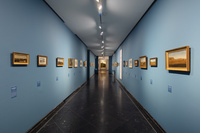
The exhibition emphasizes the importance of Paul, and in particular his accomplishments as a landscape painter. (Co-curator Elena Marchetti is the author of a doctoral thesis on the artist.) Paul’s talent is first revealed in the fourth section of the show, entitled “The Discovery of Nature,” which includes several views created by the brothers at different stages of their Italian sojourns (fig. 3). Hippolyte reencountered Ingres in Italy when the latter became director of the Villa Medici in 1835. Master and student produced highly poetic drawings and watercolors that the contemporary eye can’t help but observe with a longer history of modernism in mind. These panoramic sketches in an oblong format depict various peninsular regions. Their direct, aerial, minimalist, and floating qualities lend them an autonomous artistic character. They are more than simple exercises, and their subtlety becomes increasingly apparent as one progresses through the exhibition.
Auguste returned to Lyon after his brief foray into Italy, devoted himself mainly to portraiture, and died prematurely in 1842. In contrast, Paul chose the way of landscape painting, which was then benefitting from a flourishing market. He surveyed the French terroir from the Midi to the Norman coast, in search of picturesque motifs and viewpoints. An amusing satirical self-portrait depicts him as a mobile artist, fully equipped with a box of colors, an umbrella, and a flask, ready to roam the outdoors. His stunning landscapes oscillate between reminiscences of Camille Corot (the one admired and famously interpreted by Peter Galassi), the graphic reductions of Maurice Denis’ green trees, and the philosophically reasoned nature of another Paul, born in 1839 in Aix-en-Provence. The quality of the painter’s sketches and studies is confirmed by his more elaborate compositions, in which the Böcklinian pastoral scenes give birth to a strange instability, if not a feeling of panic and anxiety. This flight into the idyllic as an alternative way of apprehending a nineteenth-century environment in full metamorphosis constitutes a topic per se, and begs for a European approach to this kind of imaginary. Far from obeying any documentary intention, Paul’s French landscapes are also the pretext for an interesting “orientalization” of the local, which then became a springboard for his fantasized, distant elsewhere, placing the artist, in Marchetti’s words, “ahead of the spirit of an entire era” (180; fig. 4).
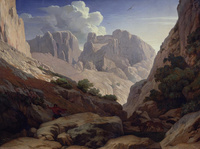
The segment of the exhibition about large-scale history paintings brings viewers immediately back to the question of codification and constraints of this genre, to which the Flandrins mainly devoted themselves at the beginning of their career. This chapter centers around Auguste’s Savonarola Preaching in the Church of San Miniato in Florence (1840), which responded to the revival and various appropriations of the story of the Dominican friar in the 1830s. During the elaboration of his painting (the artist had visited San Miniato on his way back from Rome to Lyon), Auguste received the constant support of his friends and his brother Hippolyte, all of whom were determined to help him out by stimulating his creative process. Despite its size, the painting was perceived as a genre painting at the time of its presentation at the Parisian Salon of 1840. The disturbing image blended different spaces and chronologies, arbitrarily embedding, for example, a fragment of Giotto’s fresco from the Scrovegni Chapel in San Miniato’s architecture. Auguste died abruptly two years later, an event that can be associated with the astonishing, unsettling—and most likely unfinished—Pietà painted by Hippolyte in 1842, which closes the section (fig. 5). Never shown during the artist’s lifetime and first presented to the public in 1914, the large-format oil on canvas depicts the dead Christ with the features of his brother. This peculiar work of great dramatic intensity is marked by its powerful formal synthesis, and verges, according to Paccoud, on “a certain abstraction” (125).
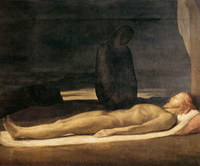
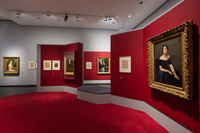
Preceding a section addressing the religious décors is one devoted to portraiture, in which the creative processes of the three brothers again enter into dialogue (fig. 6). Paul depicts his comrades in Ingres’ Parisian atelier or the Villa Medici in a series of drawings bearing the strong influence of the master. Those works focus on faces and highlight the subjective intensity of their models, without neglecting the general structure. Auguste’s portraits are small in size, generally sober, and often dedicated to local notables. Against the idea of a “provincial” style, Marchetti and Paccoud argue that the brothers’ approach to the genre belongs to the Biedermeier trend, while pointing the different modalities of the filiation to Ingres again—to whose Bertin (1832) the Portrait of Alexis Champagne (1842), Auguste’s most ambitious portrait, is compared. Hippolyte, for his part, saw many great names of his time parade by, even the Emperor Napoleon III, who posed for him in the Tuileries. The exhibition permits viewers to observe several choice examples of his achievements as a portrait painter, including a canvas in which his wife Aimée Flandrin emerges from a symphony of dark tones. Wearing a black dress, she appears in front of a cropped picture by an Italian primitive that probably belonged to the painter.
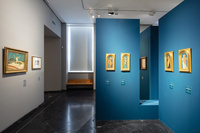
The penultimate section, devoted to the painted religious décors created by Hippolyte and Paul as part of the revival of the genre at the time, gives pride of place to the Parisian church of Saint-Germain-des-Prés (fig. 7). The show thus unfortunately neglects the other commissions of importance received by the brothers, such as Saint-Séverin (Paris), Saint-Paul (Nîmes), and Saint-Martin-d’Ainy (Lyon). This, however, is an understandable choice, considering the recent restoration of the Saint-Germain-des-Prés cycle (2016–20), which gave back to this central piece of ninenteenth-century religious painting all of its dignity. Produced by the company Iconem in partnership with the City of Paris and the support of the FRAME network, one room of the exhibition offers an immersive dive into the digitized decorations through multiple projection screens. This spectacular device permits visitors to measure the extent and coherence of the work realized by Hippolyte with the support of Paul, who ensured the completion of the cycle after the death of his brother. Profiting from the murals’ restoration, the exhibition catalogue provides a precise technical analysis of the encaustic technique—which was used with an eye toward reviving ancient painting processes (see Émilie Checroun and Louise Delbarre’s contribution in the catalogue, 280–89). This method made it possible to associate vivid colors with the matte surface of the frescoes that brothers studied in situ during their Italian stay.
The exhibition ends with the expected question of heritage and filiations, in a section that features artists such as Maurice Denis and of course Edgar Degas, who remained attached to the classical ligne all his life and trained with Louis Lamothe, one of Hippolyte’s followers. But the show also offers some comparisons with artists from later periods. The presence of photographs by Wilhelm von Gloeden and Robert Mapplethorpe immediately raise the question of a homoeroticism that neither the exhibition nor the catalogue deals with in any detail. The well-known and particularly rich legacy of the Naked Young Man (1835–36), famous to the point of being almost entirely detached from its author’s name, could have served here as an entry point for a more thorough contextualization and analysis of this cross-cutting topic. As for Rineke Dijkstra’s beach portraits of the 1990s, their awkward staging of siblings seem merely illustrative and are difficult to connect to the Flandrins’ artistic concerns. Perhaps this is one of the weaknesses of the exhibition: it broaches important interpretative and historiographic questions, but neither it nor the catalogue, which abounds in factual considerations, develop them fully. Thus, the discourse on bodies and anatomy remains mainly associated with the context of pictorial academism, the reflections on the auctorial dimension of the siblings’ intertwined practices do not benefit from a more advanced theoretical approach, while the study of the société in which the three brothers evolved never turns into an actual social art history.
The “triography” presented at the Lyon museum is nonetheless an important exhibition that reveals the subtleties and richness of nineteenth-century French academic painting, and allows the general public to apprehend less commonly shown figures. Prepared and opened in the context of the pandemic, the event also responds to the dramatic loss of Hippolyte’s Saint Clair Healing the Blind, one of his 1836 submissions from Rome, in the fire that destroyed the cathedral of Nantes in 2020. The Louvre Museum preserves a reduced copy: it is by the hand of his brother Paul.
Notes
[1] Jacques Foucart, “Introduction,” in Hippolyte, Auguste et Paul Flandrin: une fraternité picturale au XIXe siècle (Paris: Réunion des Musées Nationaux, 1984), 7.
[2] Frédéric Edelmann, “Les Flandrin au musée du Luxembourg. Hippolyte, Auguste, Paul et les autres,” Le Monde, January 12, 1985, https://www.lemonde.fr/.